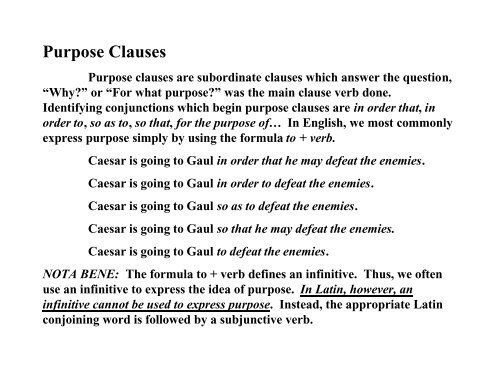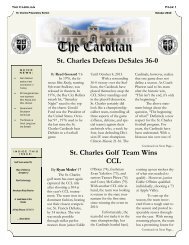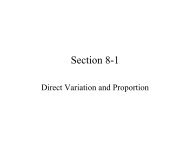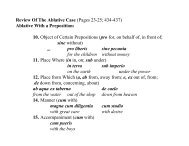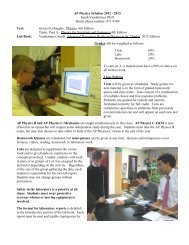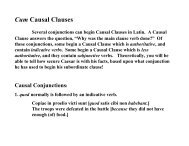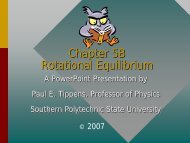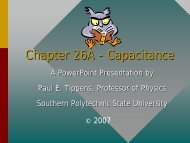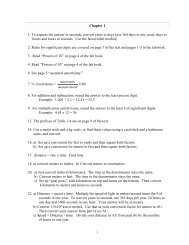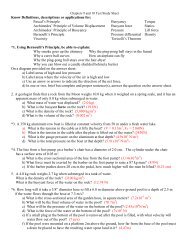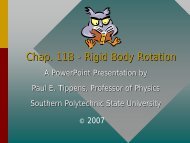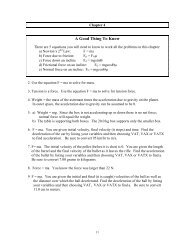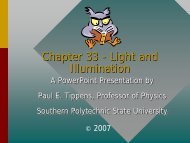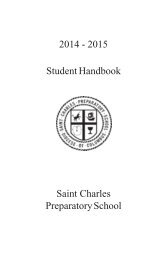Purpose Clauses
Purpose Clauses
Purpose Clauses
You also want an ePaper? Increase the reach of your titles
YUMPU automatically turns print PDFs into web optimized ePapers that Google loves.
<strong>Purpose</strong> <strong>Clauses</strong><strong>Purpose</strong> clauses are subordinate clauses which answer the question,“Why?” or “For what purpose?” was the main clause verb done.Identifying conjunctions which begin purpose clauses are in order that, inorder to, so as to, so that, for the purpose of… In English, we most commonlyexpress purpose simply by using the formula to + verb.Caesar is going to Gaul in order that he may defeat the enemies.Caesar is going to Gaul in order to defeat the enemies.Caesar is going to Gaul so as to defeat the enemies.Caesar is going to Gaul so that he may defeat the enemies.Caesar is going to Gaul to defeat the enemies.NOTA BENE: The formula to + verb defines an infinitive. Thus, we oftenuse an infinitive to express the idea of purpose. In Latin, however, aninfinitive cannot be used to express purpose. Instead, the appropriate Latinconjoining word is followed by a subjunctive verb.
2. Substantive Result <strong>Clauses</strong> are introduced by a special verb inthe main clause:accidit (impersonal) = it happens…evenit (impersonal) = it happens…fit (impersonal) = it happens…necesse est (impersonal) = it is necessary…efficio (personal) = (someone) brings it about…The Result Clause begins with ut, and contains a present or imperfectsubjunctive.Accidit ut Caesar ad oppidum alienum appropinquet.It happens that Caesar is approaching the barbarian town.Dux effecit ut captivi ad provinciam suam reverterentur.The general brought it about that the prisoners were returned to theirprovince.
The Sequence of Tenses Rule for <strong>Purpose</strong> and Result<strong>Clauses</strong>Just like infinitives and participles, subjunctive verbs insubordinate clauses show, by their tense, when their action occurs relativeto the time of the main clause verb. The Sequence of Tenses Rule for<strong>Purpose</strong> and Result <strong>Clauses</strong> is simple.Primary Sequence:Main Clause verb isPresent IndicativeFuture IndicativeFuture Perfect IndicativeSecondary Sequence:Main Clause verb isImperfect IndicativePerfect IndicativePluperfect IndicativeSubordinate Clause verb isPresent SubjunctiveSubordinate Clause verb isImperfect Subjunctive
Special Notes about <strong>Purpose</strong> and Result <strong>Clauses</strong>1. When beginning a <strong>Purpose</strong> Clause, ut means “in orderthat…,” “for the purpose of…,” etc.; when beginning aResult Clause, ut can only mean “that…,” “with the resultthat…”2. Be very careful to make the following distinction: InEnglish, so that signifies purpose, when so and that are sideby side. When so and that are separated by one or morewords, they signify result:<strong>Purpose</strong>: He ran quickly so that he would surpass theenemy.Result: He ran so quickly that he surpassed the enemy.3. The action of the subjunctive verb in a <strong>Purpose</strong> Clause or ina Result Clause is assumed to happen at the same time as themain clause verb.
Quiz #6: The vocabulary words in the Words to Master list onPage 94 .


